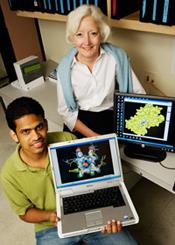

In some parts of the world, mosquitoes are a matter of life and death. Every year, nearly 3 million people die of malaria, which is transmitted by mosquitoes. Roughly 80 to 90 percent of those deaths occur in Africa, and the most susceptible are children under the age of five.
LAS researchers are in the thick of the battle against malarial mosquitoes, having recently discovered which protein gives the mosquitoes resistance to the insecticide DDT. The U of I team is now looking for compounds that can inhibit this protein, making it much easier to exterminate pests that transmit the deadly disease.
One of the ways that health officials battle malaria in Africa is by spraying the residual insecticide, DDT, on the walls of homes, says Mary Schuler, a U of I professor in cell and developmental biology, biochemistry, and plant biology. DDT has an infamous reputation in the United States, banned since 1972, but in developing countries it remains one of the most potent tools in combating malaria-carrying mosquitoes.
Molecular modeling shows how the DDT molecule (aqua, white, and bronze spheres) is predicted to interact with the active site of two P450 proteins, CYP6Z1 (tan) and CYP6Z2 (green). An amino acid, Arginine 208 (purple), blocks the active site of CYP6Z2, preventing DDT from docking with it. This model accurately predicted that CYP6Z1 could metabolize DDT, whereas CYP6Z2 could not. (Animation by Sanjeewa Rupasinghe and Michael Hallock.)
The U of I team discovered that the protein known as CYP6Z1 metabolized DDT in Anopheles gambiae mosquitoes, a species that contains many strains capable of transmitting the malarial parasite to humans and animals, Schuler says. By metabolizing DDT, the mosquito becomes resistant to the insecticide.
Now that U of I researchers have pinpointed a key protein responsible for building resistance to DDT, they are conducting “virtual screens,” in which the computer predicts what compounds will inhibit this protein. Once the list of potential inhibitors has been narrowed, Schuler says their next stage is to do actual biochemical screening, which will determine if the compounds actually prevent the mosquitoes from building DDT resistance.
“In this project, we cover it all, from A to Z,” she notes.
The inhibitors, which entomologists call “insecticide synergists,” can be mixed with the insecticide to prevent the mosquitoes from building resistance to DDT and other chemicals.
What’s more, these findings not only apply to malaria, Schuler adds. They can also be used in efforts to control mosquitoes that transmit other deadly diseases, including yellow fever and West Nile disease.
Schuler says that groundwork for the research on mosquitoes was laid by her research with May Berenbaum, the head of entomology at U of I. They have studied how many different insects break down insecticides, with a particular focus on corn earworms. Schuler is also working with LAS entomology researcher Barry Pittendrigh to find ways to inactivate the genes that create the protein behind DDT resistance in mosquitoes.
As she puts it, “There’s a lot out there that still has to be learned about mosquito populations in the wild.”


